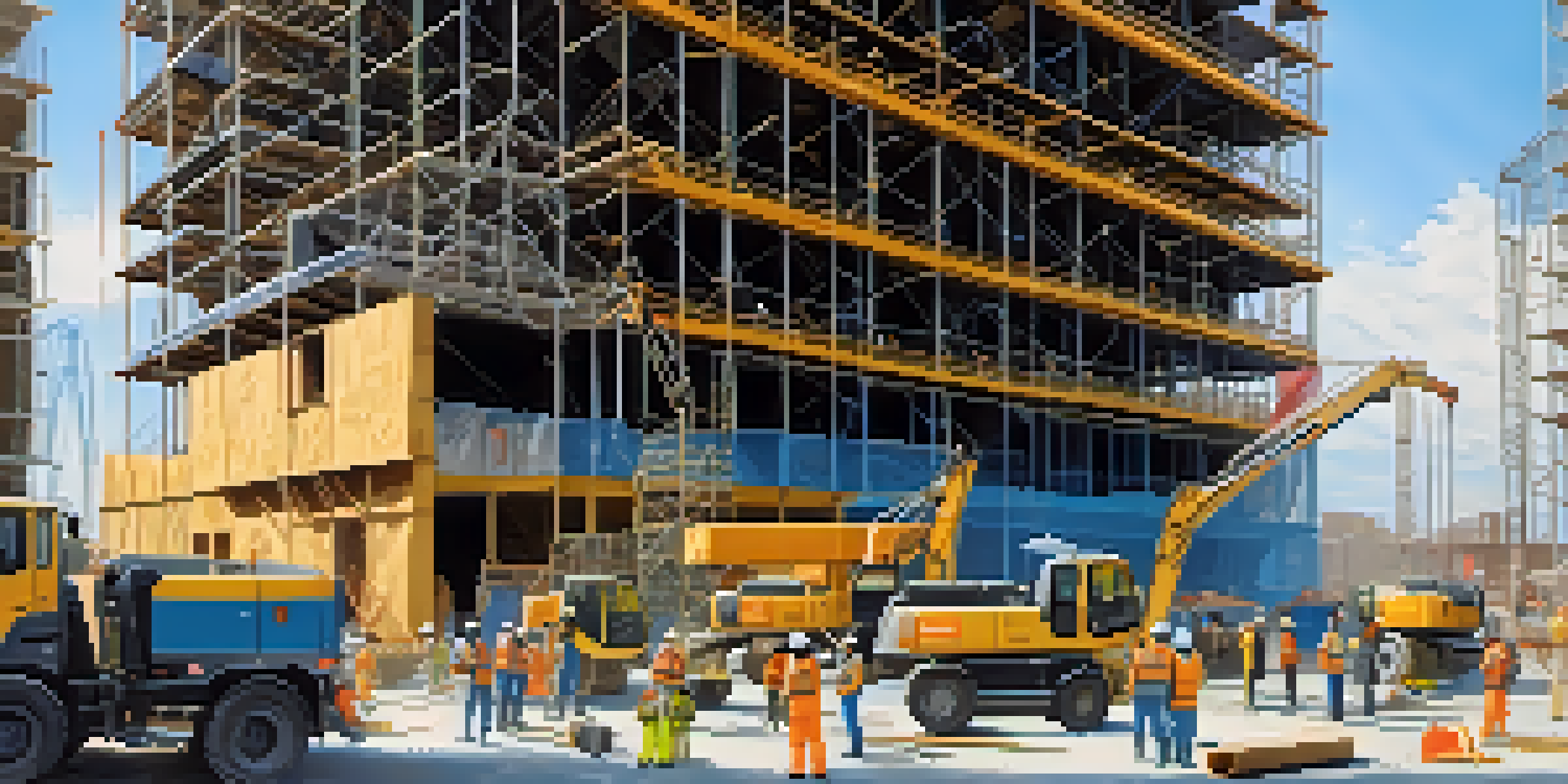How to Handle Contractor Delays and Setbacks

Understanding Common Causes of Contractor Delays
Contractor delays can stem from various factors, including weather issues, labor shortages, or material supply problems. Understanding these causes is crucial for managing expectations and planning accordingly. For instance, if a contractor faces unexpected rain, it can halt outdoor work, causing delays. By identifying and anticipating these common setbacks, you can better prepare for potential disruptions.
The single biggest problem in communication is the illusion that it has taken place.
Another common reason for delays is miscommunication between contractors and clients. Clear communication not only helps set realistic timelines but also establishes trust. If a contractor is unsure about the project scope or requirements, it can lead to mistakes that may cause further delays. Regular check-ins can help ensure everyone is on the same page, minimizing these risks.
Lastly, project planning and scheduling issues can also contribute to setbacks. If a contractor is juggling multiple projects or hasn't allocated enough resources, it can lead to delays. To mitigate this, consider discussing timelines and resource allocation upfront, ensuring that your project receives the attention it deserves.
Setting Realistic Expectations with Your Contractor
Setting realistic expectations from the beginning is crucial in any contractor-client relationship. This means discussing timelines, budgets, and project scope thoroughly. When both parties have clear and agreed-upon expectations, it significantly reduces the chances of misunderstandings that could lead to delays. For example, if you know that certain materials take longer to arrive, you can plan your timeline accordingly.

In addition to discussing timelines, it’s essential to be flexible. Sometimes, unexpected obstacles arise, and being open to adjusting your expectations can help maintain a positive working relationship. A little flexibility can go a long way, such as allowing for additional time if the contractor encounters a hiccup. This approach fosters teamwork and cooperation.
Understand Causes of Delays
Identifying common causes of contractor delays, such as miscommunication and planning issues, helps in better project management.
Lastly, don’t hesitate to ask for regular updates on the project’s progress. Frequent communication can help you stay informed and prepared for any potential delays. By maintaining a dialogue, you can address any concerns early on, ensuring that everyone remains aligned and focused on the project's goals.
Creating a Contingency Plan for Delays
A contingency plan is a safety net that prepares you for unforeseen circumstances, such as contractor delays. By outlining alternative steps to take if things don't go as planned, you can minimize disruptions to your project. For instance, if a contractor can't complete a task on time, having a secondary contractor in mind can help keep things moving forward.
Plans are nothing; planning is everything.
When developing your contingency plan, consider potential risks and their impact on your project. This could involve budget adjustments, timeline extensions, or even changes in project scope. By identifying these risks upfront, you can create a proactive strategy rather than a reactive one. This foresight can save you time and stress later on.
Moreover, it's important to communicate your contingency plan with your contractor. Having a shared understanding of how to address delays can enhance collaboration and reduce tension. This way, both parties can work together to navigate setbacks, ensuring that the project stays on track as much as possible.
Maintaining Open Communication with Contractors
Open communication is the backbone of any successful project. When working with contractors, establishing a clear line of communication from the start is essential. This includes discussing preferred communication methods, frequency of updates, and how to address concerns. By ensuring everyone knows how to reach each other, you can quickly resolve issues as they arise.
Additionally, regular check-ins can help maintain momentum and address any potential delays before they become significant problems. You might schedule weekly meetings or calls to discuss progress and challenges. This proactive approach fosters a sense of teamwork and encourages accountability on both sides.
Set Realistic Expectations
Thoroughly discussing timelines and being flexible can significantly reduce misunderstandings between contractors and clients.
Lastly, be open to receiving feedback from your contractor. They may have insights or suggestions that can improve the project and help you avoid setbacks. By creating a two-way communication channel, you not only empower your contractor but also build a stronger partnership, making it easier to navigate any bumps in the road together.
Documenting Everything: Contracts and Agreements
Documentation is a vital aspect of any contractor relationship. Having a detailed contract that outlines the project scope, timelines, and payment terms can protect both you and the contractor. If delays occur, referring back to the contract can clarify obligations and expectations. This document serves as a roadmap for your project, ensuring everyone is on the same page.
In addition to the initial contract, it's wise to document any changes made throughout the project. If modifications to the timeline or scope are necessary, ensure these are recorded and agreed upon by both parties. This not only helps prevent misunderstandings but also provides a clear record of the project's evolution.
Lastly, maintaining communication logs can also be beneficial. Keeping track of conversations, emails, and decisions made can serve as a reference point if issues arise. This level of documentation creates accountability and transparency, making it easier to address any contractor delays or setbacks that may occur.
Finding Solutions Together: Collaborative Problem-Solving
When contractor delays occur, it's essential to approach the situation with a collaborative mindset. Instead of placing blame or expressing frustration, focus on finding solutions together. This approach can foster a positive working relationship and encourage open dialogue about challenges and potential fixes. For example, if a delay is caused by a material shortage, brainstorming alternative suppliers can be a productive way to move forward.
Encouraging your contractor to share their perspective can provide valuable insights into the challenges they face. Understanding their constraints can help you work together to devise realistic solutions. This partnership not only addresses immediate issues but also builds trust and collaboration for future projects.
Maintain Open Communication
Establishing a clear communication strategy fosters collaboration and helps address potential delays before they escalate.
Lastly, be willing to compromise when necessary. Sometimes, a solution may require both parties to make adjustments. Whether that means altering timelines or reallocating resources, a willingness to adapt can help keep the project on track. By working together, you can overcome setbacks and achieve the desired results.
Knowing When to Seek Legal Advice
While most contractor relationships are built on trust and collaboration, there may be times when delays escalate into serious issues. If you encounter persistent delays or breaches of contract, it may be time to seek legal advice. Understanding your rights and obligations can help you navigate these situations more effectively. A lawyer experienced in construction law can provide guidance tailored to your specific circumstances.
Before taking legal action, consider whether there are alternative dispute resolution options available. Mediation or arbitration can often resolve conflicts without the need for a lengthy legal process. These methods allow both parties to discuss their concerns in a neutral setting, often leading to a more amicable resolution.

Ultimately, legal action should be a last resort. It's essential to document all interactions and attempts to resolve the issue amicably before pursuing legal channels. This not only protects your interests but also demonstrates your commitment to finding a fair solution, which can be beneficial should the matter escalate further.